Tomatoes in the greenhouse disease photo
Every gardener who grows tomatoes in a greenhouse hopes for a generous harvest. But to achieve success in this seemingly simple business is not so simple. The whole problem is that tomatoes often get sick. And not every gardener knows how to deal with a particular disease. If the necessary measures are not taken in time, then one can not even dream of a good harvest. But what a shame when the invested work does not bring the desired results! It often happens that a person who has failed only once ceases to do what he loves.
You can lose such disappointments only by arming yourself with the necessary information that will help you recognize the enemy in the "face" and act correctly and immediately. Therefore, it is necessary to consider in more detail the diseases of tomatoes and seedlings grown in a greenhouse. After all, as you know, the disease is easier to prevent than to treat. This can be done by properly preparing tomato seeds before sowing.
Preparing tomato seeds for sowing
Many gardeners believe that the quality of the future harvest depends on the preparation of seeds. These are fairly simple manipulations that anyone can do.
Stages of preparing seeds for sowing
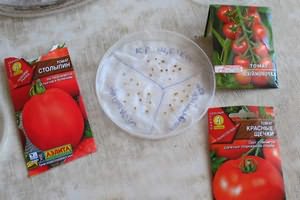
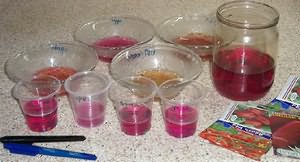
If you didn’t manage to find the ash, then you can replace it with the same amount of Ideal liquid fertilizer or a quarter teaspoon of sodium humate powder. The solution must be warm.
Next, the seed bags are placed in a solution and kept there for half a day. After this time, they must be lowered into clean water and left warm for another day. This manipulation is of particular importance for tomato seeds, which are large in size.
- Seed hardening. It is needed so that the tomatoes are not afraid of the cold. It also contributes to the cultivation of stronger seedlings. To do this, the seed bags must be placed in a cool place (refrigerator for example) and left for 2 days. As soon as the bags begin to dry out, they need to be sprayed with water. Further, the seeds cooled in this way are sown and wait for quick friendly shoots.
The most common tomato diseases in the greenhouse and how to deal with them
There are many diseases that affect tomatoes, and each of them needs the right approach. The main pests are microscopic fungi, viruses, bacteria and also insects.
Consider each disease and how to deal with it in more detail.
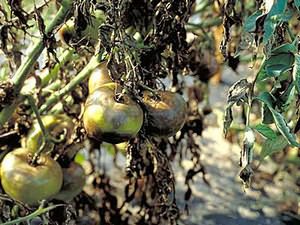
Phytophthora infection is the most common disease. This is a fungus that spreads almost throughout the plant.
Signs of the disease:
- Stems and leaves are covered with brown spots.
- There is a slight white coating on the underside of the leaf.
- Brown spots appear under the skin of the fruit.
Factors such as a large temperature drop and an increase in humidity help late blight spread. A sharp decrease in the incidence of tomatoes contributes to the cultivation of hybrids.
Control measures:
- 3 weeks after planting the seedlings, it must be sprayed with the Barrier solution. After another 3 weeks, it is necessary to re-treat with another drug - "Barrier".
- When the plant has already bloomed, it can be sprayed with a garlic solution. The solution is made as follows: 250 grams of garlic must be ground with a meat grinder and diluted with 10 liters of water and add 1 gram of potassium permanganate.
- Also, the treatment of late blight with Oksikhom, two tablets of which are diluted in 10 liters of water, gives positive results.
- For prevention, tomatoes should be treated before they bloom (when they are in the seedling stage) or when signs of the disease are just beginning to appear.
Blossom end rot of tomatoes
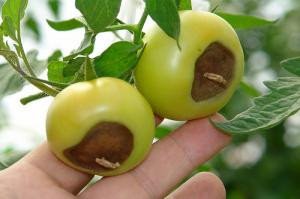
Signs of the disease: green fruits are covered with sunken spots. They are either dry, black, shiny, or watery with a characteristic putrid odor.
Causes of the disease:
- lack of moisture;
- excess nitrogen in the soil;
- lack of an element such as calcium.
Control measures:
- Regular irrigation, especially in the heat.
- Treatment of a diseased plant with nitrate solution. They do it like this: one tablespoon of calcium nitrate is mixed with 10 liters of water.
- Fruit affected by the disease must be burned.
leaf mold
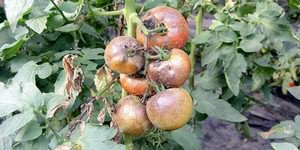
Also a fairly common disease that affects tomato leaves in a polycarbonate greenhouse. To be able to recognize this disease, look at the photo.
Signs of the disease:
- The appearance of brown-brown spots that have a velvety gray coating.
- They are located on the back of the sheet.
- Drying of the affected leaves, up to the death of the plant.
Ways to spread fungal spores:
- Transfer from one plant to another during watering.
- From the clothes of gardeners.
- Preservation of them in the ground and on last year's leaves.
Disease treatment:
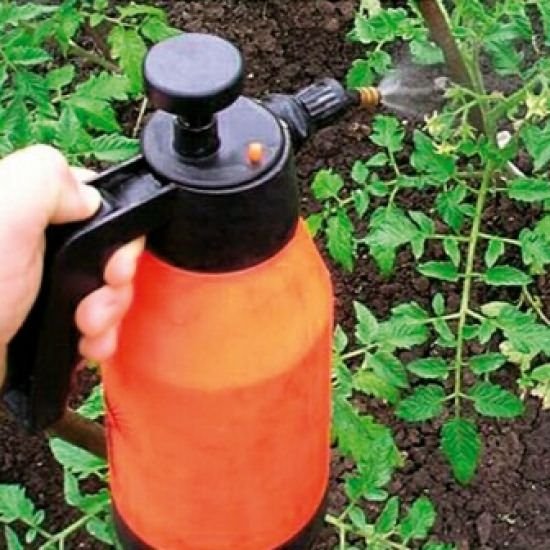
- Reducing air humidity.
- Reducing watering.
- Temperature rise.
Prevention measures:
- Treatment of the plant, including its seedlings, with a solution of copper oxychloride, 30-40 grams of which is diluted in 10 liters of water.
- Spraying with Oxychoma solution - two tablets per 10 liters of liquid.
- The use of bacterial preparations, such as "Barrier" "Barrier".
- Disinfection of the greenhouse, which is carried out after harvesting. To do this, a glass of copper sulfate is mixed with 10 liters of water and this solution is sprayed not only with old plants, but also with soil and roofing.
- Next year, growing tomatoes in the same polycarbonate greenhouse is not worth it.
- Cultivation of modern varieties and hybrids.
Mosaic
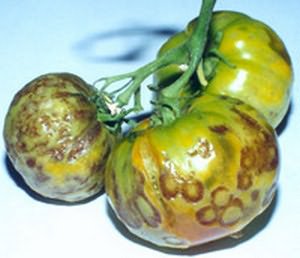
Tomato mosaic is a very unpleasant disease caused by viruses, often leading to crop loss and death of bushes.
Signs of the disease:
- Changing the shape and color of the leaves.
- The appearance of yellowish-green spots.
- Leaves curl and wrinkle.
- Inhibition of the plant, which leads to a decrease in the yield of tomatoes, yellowing and subsequent drying.
Control measures:
- Removal and burning of affected plants.
- Preliminary half-hour treatment of seeds in a one percent solution of potassium permanganate.
- Watering the seedlings with the same solution several times a day at intervals of 3 weeks.
Preventive measures:
- Treatment of seedlings with a solution of skimmed milk every ten days. It is made like this: 1 liter of milk is diluted in ten liters of water with the addition of a teaspoon of urea.
- For sowing, 2-3-year-old seeds are preferable.
- The disease is transmitted through plant sap. Therefore, you do not need to touch it, stepson tomatoes.
- It is better to choose mosaic-resistant varieties and hybrids.
- Early sowing of seeds.
Gray rot of tomato fruits
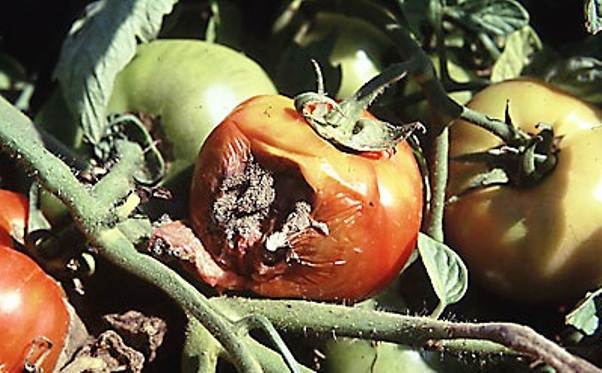
This is a disease caused by fungi. The defeat of the fruits of tomatoes occurs, as a rule, at the very end of the growing season, when cold and rain come.
Signs of the disease:
- The appearance of small rounded spots, which eventually begin to increase and release a brown liquid.
- The occurrence of gray mold on the stems, leaves and flowers of the plant.
If you notice gray rot while growing tomatoes in a polycarbonate greenhouse, then you need to do the following:
- Remove affected fruits and other organs of the plant;
- Raise the temperature;
- Spray diseased tomatoes with drugs such as Fundazol, "Barrier" or "Barrier".
Root rot of tomatoes
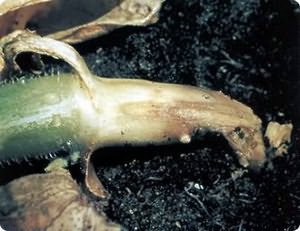
It is characterized by wilting of plants, as their root neck begins to rot. This disease can also affect cucumbers.
Control measures:
- Disinfection of the soil with a solution of copper sulfate.
- Removing the diseased topsoil in the greenhouse and adding fresh.
- Processing "Barrier" and "Barrier".
Brown rot (phoma) of tomatoes
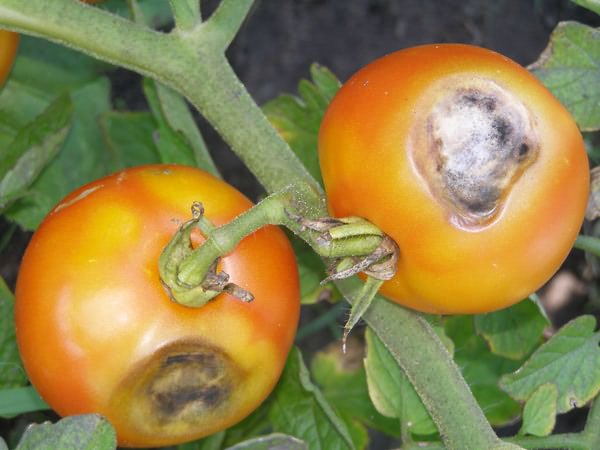
This is a disease caused by fungi. It affects only the fruits ( on the picture).
Signs of the disease:
- A small brown spot appears at the base of the fetus.
- Breakage of green tomatoes with their subsequent fall.
Control measures:
- Avoid high humidity.
- Do not feed plants with fresh manure and large amounts of nitrogen.
- Soil disinfection.
- Collection and destruction of affected fruits.
Macrosporiosis or dry spotting
signs of disease ( on the picture):
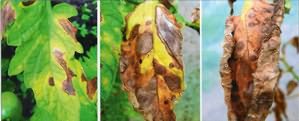
- The appearance of rather large brown spots.
- Death of severely affected leaves.
- Dark spots at the base of the fruit.
- The appearance of a black velvety coating.
Control measures are the same as for phytophthora.
Cracking of tomato fruit
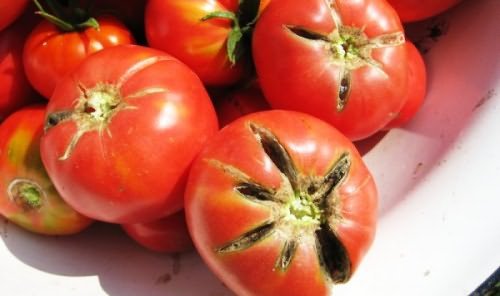
This is not an infectious, but a physiological disease. The reason is watering the plant in a drought with a large amount of liquid at once. There is a rapid flow of water into the fruit and the rupture of the tissue cell walls.
Control measures:
- Moderate watering.
- If you grow tomatoes in a greenhouse, then in the heat you should spray it with a solution of lime.
- In addition to the above diseases, which you can look at in the photo, tomatoes are often affected by pests.
- Medvedka is a rather large (up to 5 centimeters) brown insect that has large paws with which it can dig. She loves damp soil rich in manure.
Control measures:
- The use of the drug "Thunder".
- Pouring into the mink of a pest infusion of hot pepper or table vinegar.
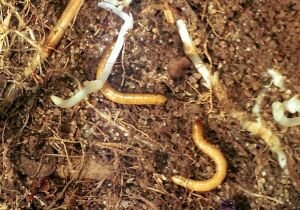
Wireworms are yellow caterpillars that can damage the roots and stem of tomatoes.
Control measures:
- Sticks will help get rid of this pest. You need to string vegetables on them and bury them in the ground so that the tips of the sticks stick out. A few days later, the sticks in which the wireworms have accumulated must be pulled out and burned.
- When digging the soil in a greenhouse, wireworms should be collected and destroyed.
- It is also possible to reduce their number by liming the soil and applying mineral fertilizers.
Whitefly and Owl
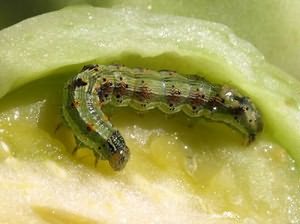
Whiteflies are also quite common insects in the greenhouse. Their larvae are able to suck the juices from the leaves, and over time this can lead to the fact that the tomatoes die.
Control measures - treatment with Phosbecid or Citcor.
Gnawing scoops are gray or black caterpillars that can cause severe damage to tomatoes.
To protect your crop grown in a greenhouse, you need:
- Destroy weeds.
- Dig deep into the soil.
- Collect caterpillars.
- Treat plants and their fruits with Strela.
As you can see, getting rid of diseases is not difficult, it is enough to know the methods of dealing with them. And then tomatoes will delight you with their juicy and healthy fruits.
LetovSadu.ru
Tomato diseases in the greenhouse: treatment and prevention
Many gardeners, wanting to grow an early harvest on their plots, build greenhouses where tomatoes and cucumbers ripen much earlier than their neighbors in the open field. And yet, growing vegetables in greenhouses, people are trying to protect the plant from adverse external factors, acid rain, the scorching sun, etc. It is possible that plants under film cover will be protected from something, but do not forget that in protected ground for bacterial diseases ideal conditions are created. Most often, tomatoes and cucumbers are grown in greenhouses. It is known that over the past decade, the yield of the most popular vegetable - the tomato - has been declining at a rapid pace. Tomato diseases in the greenhouse and in the open field do their dirty work. This article will discuss diseases and ways to deal with dangerous bacteria that infect tomatoes.
Diseases of a tomato in a greenhouse. Types and methods of treatment
Climate change, the widespread use of fungicides has led to the fact that bacteria have adapted to many natural factors and all kinds of chemicals. And as a result - a wide spread of bacterial diseases that affect plants. In addition, many tomato diseases have mutated, and it is now quite difficult to distinguish one disease from another. In order to successfully fight the "enemy", it is necessary to accurately determine its pathogens. Tomato diseases in a greenhouse develop more intensively and affect almost all plants.
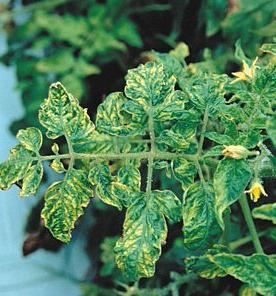
Mosaic
With this disease, the leaves of the plant are deformed, their color changes. Tomatoes look oppressed. They give a low yield. In order to get rid of the virus, affected plants are burned. And to prevent the disease, the seeds are soaked in a weak solution of manganese before planting. Planted seedlings are also watered with a solution of potassium permanganate. Processing a tomato for diseases, as a rule, consists in spraying plants. With this disease, tomatoes are sprayed with skim milk. To do this, add a liter of milk and a teaspoon of urea to ten liters of water. Spray seedlings every three days.
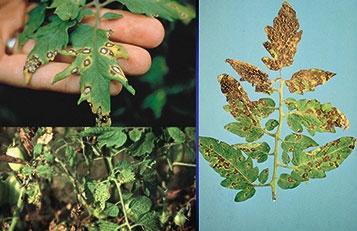
Leaf mold and brown spot
Diseases affect the leaves and trunk of the plant. Brown spots with a gray coating appear on the underside of the leaf. Subsequently, the leaves fall off, and the plant dies. The cause of the disease is waterlogging of the soil, as well as watering with cold water at low temperatures. If brown spotting has struck tomatoes, then the first thing to do is to reduce soil moisture and adjust the temperature. Sick plants must be sprayed with copper chloride (40 g per 10 liters of water). To prevent the disease, after harvesting, treat the plants, as well as the soil and walls of the greenhouse, with a solution of copper sulfate. The following year, tomatoes cannot be planted in this soil.
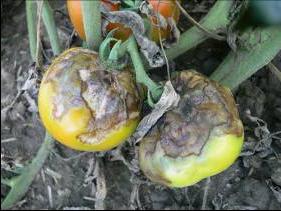
Phomosis, or brown rot
Tomato diseases in a greenhouse are very often similar to plant diseases in the open field. Phomosis belongs to such a disease. This fungal disease appears only on fruits in the form of brown spots near the stalk. The fruits do not have time to ripen and fall still green. To prevent the disease, it is necessary to avoid waterlogging the soil and not to feed the plants with fresh manure. If phomosis attacked the tomatoes, then it is necessary to treat the soil with foundationazole.
Prevention
In order for tomato diseases in the greenhouse (photos are presented in the article) not to destroy your hopes for a good harvest, buy seeds only in specialized stores. And don't forget about preventive measures.
fb.ru
Tomato diseases and their treatment - from A to Z about tomato diseases
Fungal diseases of tomatoes and their treatment
The most common are fungal diseases that can appear at low temperatures, due to heavy rainfall, due to improper care of seedlings.
Tomato disease control:
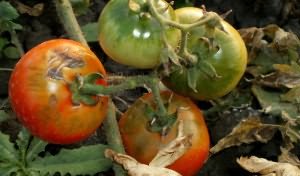
The main thing is that you should carefully read the instructions for each of the listed drugs so as not to oversaturate the plants with them. After all, this can also harm tomatoes no worse than diseases.
Bacterial diseases of tomatoes and their treatment
There are various bacterial diseases of tomatoes and measures to combat them. It is advisable to find out in advance what sores threaten your garden in order to prevent the appearance of diseases. Otherwise, you are threatened with crop loss, and diseases can spread to other crops in your garden.
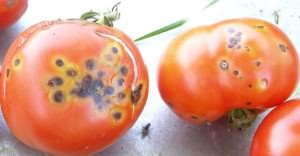
Protection and treatment of tomatoes from diseases: prevention
As you understand, there are a wide variety of diseases, and their treatment is a rather complicated process. That is why it is much easier to prevent the appearance of an infection in your garden than to fight it. And gardeners should know the basic preventive measures to protect the beds from diseases. So, for example, tomato seeds should not be planted near potatoes, as well as in the beds where you previously grew eggplant and peppers.
And if the cultures were sick with something, then it is not recommended to plant any horticultural crops on this site for at least three years.
Try not to thicken the plantings, remove the lower leaves, fight weeds. It is also important to water the plants in a dosed manner, without over-wetting them, because a high level of humidity is one of the reasons for the appearance of fungal diseases. Loosen the soil more often, do not overdo it with nitrogen fertilizing and avoid using fresh manure as a fertilizer. It is necessary that the planting of vegetables takes place according to all the rules: choose the seed material wisely and take care of the plants.
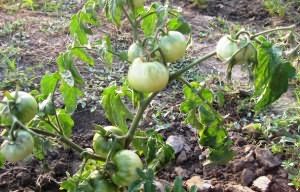
Preventive protection of tomatoes from diseases:
- Before planting, treat the seedlings with a 0.5% solution of Bordeaux mixture, and repeat the work a week later.
- Treatment with copper oxychloride helps (40 grams of the drug is used for a 10-liter bucket of water), however, work must be carried out at least 20 days before harvesting.
- You can sprinkle the soil with ash or prepare an ash infusion (200 g of ash is boiled for about 10 minutes in a liter of water, filtered through gauze, after which the liquid is poured into 10 liters of water).
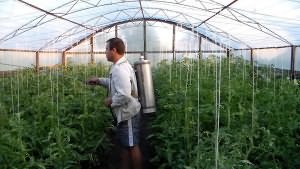
Taking preventive measures in advance will help you reduce the risk of not only diseases, but also various pests on your site. The main thing is to carry out all the work in a timely manner so that the infection does not have time to penetrate the plant.
nasotke.ru
Tomato diseases in pictures
In order to grow tasty and healthy tomatoes, you need to be aware of all the diseases that can harm your crop. In the article, you will be introduced to the main diseases of tomatoes, as well as you can see tomato diseases in pictures on the pages of our website.
Causative agents of diseases of tomatoes:
Mushrooms
Mushrooms are quite frequent guests of our personal plots. These are lower plants of microscopic size. Since they do not have their own roots and even stems, they cannot produce chlorophyll on their own. They need ready-made organics for nutrition, so consumption of plant tissues is included in their life cycle. Some fungi feed on living tissue, some on dead tissue.
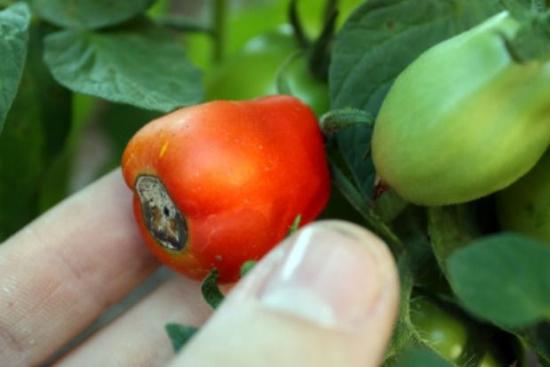
Mycelium can develop both inside plants and on the surface. There is a mixed growth of mycelium. So, fungi that cause spotting on tomato leaves belong to the first type. Mealy lesions are the second type. And white and gray rot belong to the third, mixed type.
Reproduction occurs by pieces of mycelium and spores. Spores during the growing season are carried by winds, fogs, rain, insects, as well as garden tools and clothing. The spores may have a protective coat and tolerate winter conditions well.
Infection of tomatoes occurs through various wounds, as well as natural openings in tomatoes (stomata) or simply through the skin of stems and leaves. High humidity, thickening of plantings, excess fertilizers and ambient temperatures above 20 degrees favor their reproduction.
bacteria
If the conditions for life are unfavorable, then the bacterium can turn into a spore, and in this state it can withstand the effects of sufficiently low and high temperatures, as well as acid and alkaline reactions. The conditions for the reproduction of bacteria are increased humidity of the environment (air and soil), temperature in the range from 5 to 30 degrees. Their viability is not lost for 4 years.
Viruses
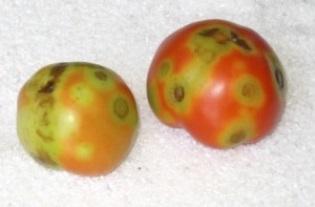
These are living protein bodies without a cell membrane, much smaller than bacteria. When they enter plant cells, they cause biochemical and functional disorders, multiplying rapidly. The transfer of the virus is carried out by sap-sucking insects (cycads, aphids, mites), garden tools. There is evidence that viruses can retain their vital activity in dry residues and storage facilities for up to 50 years.
Often the symptoms of viral lesions resemble the symptom complex of fungal and bacterial diseases, so it is difficult to differentiate them at home. Plants affected by the virus do not recover and serve as a dangerous source of infection for healthy crops on the site.
Some diseases of the tomato
Streak is a viral disease of tomatoes, also called blossom end rot. Brown spots appear on the tops of the still green tomato and leaves. The fruit becomes hard and then softens. This disease appears due to rainy summer. To avoid this, you need to improve the flow of air to the plants by removing more leaves from the lower tier. If the streak has already appeared on the plants, then you need to water the soil with a solution of potassium chloride (0.4% concentration).
Greenhouse tomatoes usually suffer from gray rot, especially if the soil pH is acidic. In this case, it is recommended to ventilate the greenhouse more often, remove leaves and fruits affected by rot. The affected foci of rot are treated with a mixture of lime and copper sulfate (2: 1). Improve the acidity of the soil by adding wood ash, dolomite and bone meal.
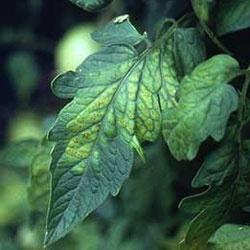
Late blight affects the entire plant. Tomato fruits turn black in a couple of days and rot. This disease usually develops in autumn, when sudden changes in temperature begin. A completely affected plant is recommended to be burned. For prevention, tomatoes should be treated with Rodomil 3 to 4 times a season.
Septoria is a fungal disease that mainly affects the stems and leaves. The main manifestations of the disease are light spots with dark edging and dark dots on the leaves. If symptoms are detected, it is necessary to spray the plants with copper chloride in the form of a soapy emulsion. Repeat the procedure after two weeks.
Strick, gray rot, late blight, septoria - all these tomato diseases in pictures are attached. We are slowly studying them, but we do not forget the simple rules of care. Monitor the development of tomatoes, remove affected bushes in a timely manner and constantly improve the soil. Remember that strong plants are not afraid of disease or pests, they will cope with them with their natural forces.
OgorodSadovod.com
Why do tomatoes crack in a greenhouse - tomato diseases.
Why do tomatoes crack in a greenhouse - tomato diseases. a source Causes of cracking tomatoes
In fact, tomato cracking is a non-infectious disease, rather just a reaction of a tender fruit to a sharp change in soil moisture. And already this is not uncommon for a greenhouse. So, the soil under a polycarbonate or film arch in sunny weather quickly warms up and dries, and abundant watering at the same time leads to the fact that too much water is supplied to the tomatoes in a short time, due to which the skin does not withstand such high pressure and breaks. Everything is very simple: due to dryness and lack of moisture in the heat, the growth of fruits stops, and the skin on them “dubes”, and at the first abundant watering, growth begins to resume, and the hardened skin simply bursts. Moreover, it is the green fruits that suffer first.
Unfortunately, the fact that tomatoes crack in a greenhouse leads not only to the loss of their presentation. Due to the violation of the integrity of their surface through the cracks, all kinds of fungi and bacteria quickly penetrate into them. Although over time, all the cracks seem to “cork”, and the risk of infection is reduced.
Of course, not all types of tomatoes are equally susceptible to cracking - it all depends on the thickness of the skin, or rather, on the variety chosen for planting. For example, some hybrids with light yellow very dense fruits are more prone to this scourge than varieties with soft fruits. According to experienced gardeners, more resistant to cracking: "Beautiful Lady", "Harlequin", "Our Masha", "Diva", "Centaur", "Favorite", "Vasilievna", "F1 Boomerang", "Podmoskovny" and " Ostrich".
How to prevent cracking tomatoes?
In order to forever stop toiling about the question of why tomatoes burst in a greenhouse, first of all, you need to equip moisture-intensive soil in it. In the summer, on especially hot sunny days, glass or polycarbonate coatings must be watered with milk of lime - only from the outside, of course.
And, if a strong drying of the soil in the greenhouse was allowed, then watering can only be carried out moderate, multiple, with interruptions.
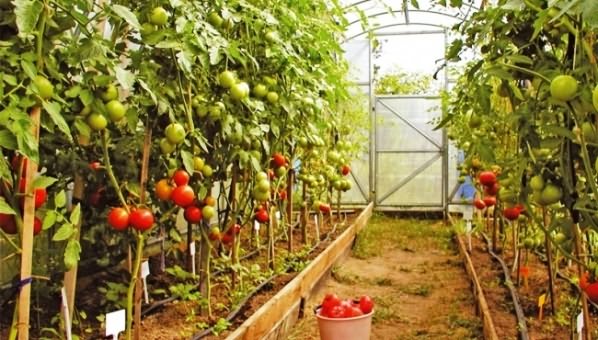
In addition to too abundant watering after the soil dries out, the following mistakes of novice summer residents also lead to cracking of tomatoes:
- Too abundant watering of plants with a large number of ripened fruits. At this stage of development, tomatoes, due to well-developed roots, are already able to take moisture from fairly deep layers of soil, even outside the greenhouse, and therefore more rare watering is needed - after 5-7 days, moreover, locally, right under the plants, without flooding the paths.
- Top dressing of tomatoes with concentrated solutions. It is much more expedient and safer to take only 20 g per whole bucket of water.
- Frequent removal of leaves. You can only remove leaves from tomatoes no more than three from one bush for the whole week.
- Excessive watering with yellowness and twisting of the leaves. In fact, this is not due to a lack of moisture - it is rather a sign that the plants need additional nutrients:
- with a lack of nitrogen, plant growth is limited, old leaves brighten, and the fruits ripen too quickly - therefore they are small;
- when there is not enough phosphorus, growth will also slow down, the leaves will be small and with curved edges, with a purple tint. And soon they will completely crumble;
- with a lack of potassium, the edges of old leaves will be as if burned. Then they turn yellow and fall off, the so-called chlorosis (yellowing) will pass to younger ones. Inside the fruits, by the way, black stripes will be visible;
- the leaves of tomatoes turn yellow and with a lack of calcium - they are deformed, and dead tissue appears on them (in separate points, which then merge).
- with a lack of copper, which is not uncommon for peaty soils, the leaves will appear whitened. Young leaves will be very small, shoots will be weak. Yes, and the flowers will be underdeveloped and crumble.
- about the lack of boron, the dying off of growth points and the formation of stepchildren will tell, which is why the plant will become more bushy. On the fruits, areas of dried tissue will be clearly visible.
- due to a lack of magnesium, yellow-green spots will appear on old leaves, which later turn gray or brown. Over time, the leaves will dry up and fall off, and the fruits will be small as a result of premature ripening.
That's why, before you start just pouring tomatoes, it's important to really make sure that they lack moisture. But if one of the listed signs of tomato beriberi accurately depicts the picture, then it's time to introduce microfertilizers into the soil.
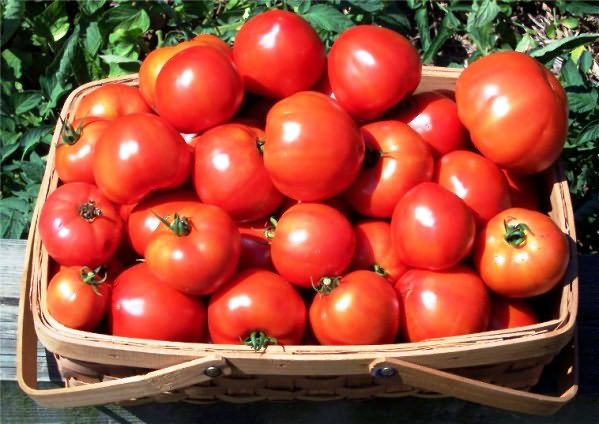
- In the early period of fruit ripening, the regularity and uniformity of watering is most important - after all, it is then that the root and above-ground parts of plants are formed. In sunny weather, tomatoes should be watered after 3-4 days, and in cloudy weather - after 4-5 days.
- In particularly hot weather in the greenhouse, it is necessary to open the doors from both ends, or in extreme cases, at least the side wall on the leeward side.
- It is better to give a dose of watering in 2-3 doses, as soon as water is absorbed into the soil, the top layer of soil will remain dry, which will help to avoid late blight.
- After cold nights with temperatures below 13 degrees, watering can only be done after 11 o'clock in the afternoon. But in the heat, you can only water in the evening, while leaving the greenhouse open all night.
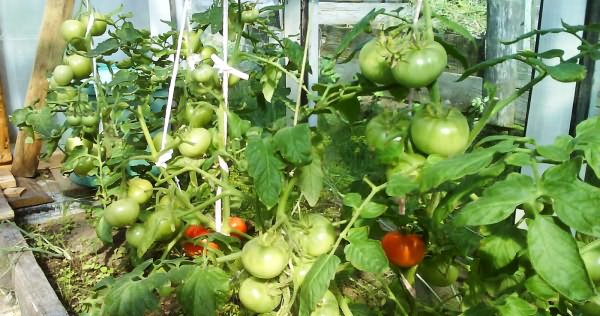
Diseases of tomatoes in the greenhouse
But the regulation of moderation and frequency of watering can only get rid of cracks in the fruits, while pests and diseases of tomatoes in the greenhouse are much more difficult to prevent.
In order for tomatoes not to get sick, it is important to carefully avoid:
- deepening into the soil mixture of the pot;
- lack of nutrients;
- excess heat and humidity;
- Violation of the regime of lighting and watering.
If all the recommendations for growing have been followed, but any spots still appear on the fruits and leaves of tomatoes, then this is really a disease or pest, and not a deterioration in the physiological state of the plant with similar symptoms. In this case, fungicides and insecticides will already be used, but it is better, of course, to get rid of the crop problem at its initial stage. And the photos and drawings that are presented below will help determine the diseases of tomatoes in the greenhouse.
Fruit Blossom Rot
This attack appears even on green fruits - in the form of a brown or black top. All this is due to a lack of calcium, or its conflict with potassium, when one blocks access to the plant to the second.
To prevent this disease, even when planting seedlings, add 1 tbsp. calcium nitrate and some charcoal. Or, as an option, spray green fruits with a solution of calcium nitrate.
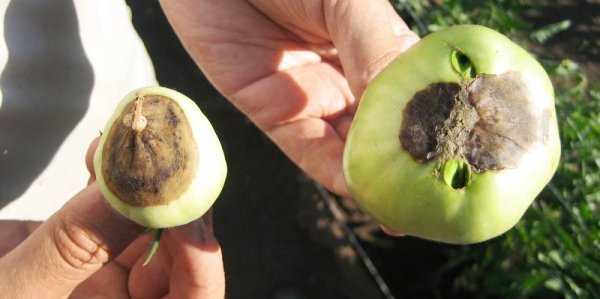
Fusarium wilt
This fungal disease affects seedlings and young plants. The infection enters through the roots, and is masked by the alleged lack of water for the plants. As a result, tomatoes wither, the lower part of their leaves turns yellow, and the stem turns black and cracks. To prevent this, it is important to observe crop rotation, and the disease can be treated with Trichodermin and Previkur preparations.
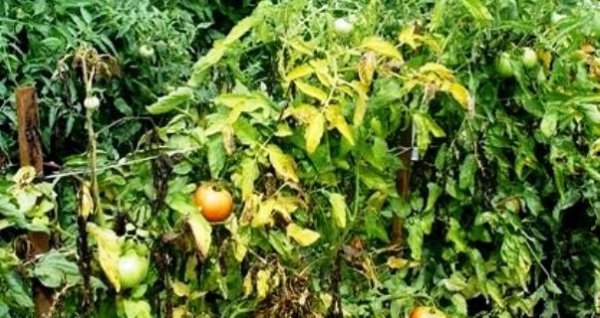
This fungus appears in cold rainy weather, affecting leaves, stems, inflorescences and fruits. You can recognize it by dark spots with a gray coating. During bad weather, you need to cut off 2-3 lower leaves on the plants - this will increase the air circulation of the lower tier, and after the weather improves, everything will pass.
late blight
This most dangerous disease can be calculated by brown spots of yellowing on drying leaves. Soon these spots pass to the fruits themselves, until the entire crop is affected. And all because of high humidity - that's why only drip irrigation or watering under the root is suitable for tomatoes. For prevention, the preparations "Mikosan" and "Pentafag" are suitable, and for treatment - Bordeaux liquid, "Tattu" and "Infinito".
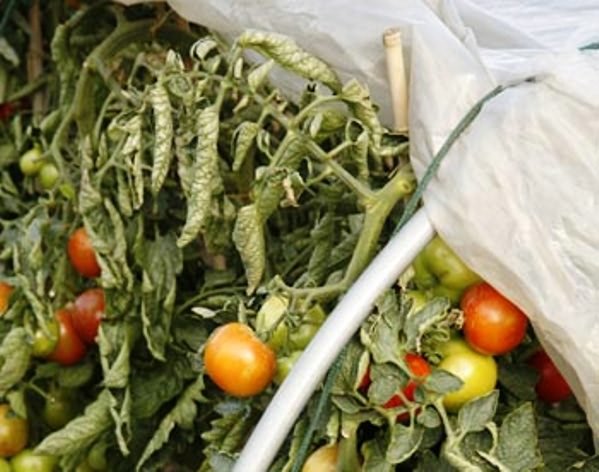
Alternariosis
This disease manifests itself with temperature fluctuations in summer and hibernates on the remains of plants in winter. It affects all above-ground parts, even the lower leaves. As a result, the fruits significantly lose their presentation. To get rid of it, landings for the night should be covered with agrofiber and treated with Acrobat, Antrakol and others.
A little patience, careful care and diligence - and tomato diseases in the greenhouse will be forever behind.




